|
|
|
Sort Order |
|
|
|
Items / Page
|
|
|
|
|
|
|
| Srl | Item |
| 1 |
ID:
127337


|
|
|
| 2 |
ID:
127593
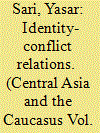

|
|
|
|
|
| Publication |
2013.
|
| Summary/Abstract |
This study aims to describe and explain the relations between identity and conflict by drawing on different theoretical approaches in political science. It examines the questions of whether collective identity, either on a national, civilizational, religious, or social level, is an important variable in trying to understand current conflicts, as well as the prospects for formulating identity-based approaches to conflict. In other words, is it even possible to think about collective identity and conflict simultaneously? This gives rise to another question: Why is collective identity an important factor for explaining the conflict in the Ferghana Valley?
The Ferghana Valley has played a role both in establishing stability in Central Asia and in becoming the starting point of violent conflict throughout the history of the region. The valley became administrationally and ethnically divided into several parts during the Soviet and post-Soviet era. Currently, the tension among the different ethnic, social, and political groups is high because of overpopulation, the increasing scarcity of water and arable land, and the economic hardships and social differentiation that occurred during the political, economic, and social transformation after the Soviet Union collapsed. The Ferghana Valley, at the heart of Central Asia, has become one of the most conflict-prone areas in Central Asia. For these reasons, the valley is a good area for testing the explanatory power of different approaches of political science to explain identity-conflict relations.
Ethnic issues are still extremely important for understanding much of the tension arising in the valley. Not only is there division among the Kyrgyz, Uzbek, and Tajik people, the issue is further complicated by the hostility between different identity-groups and minorities in the region. Additional pressure is arising due to the fact that not only does this tension exist inside each state, it could also escalate to the interstate level.
|
|
|
|
|
|
|
|
|
|
|
|
|
|
|
|
| 3 |
ID:
047374
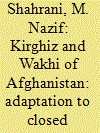

|
|
|
|
|
| Publication |
Seattle, University of Washington Press, 2002.
|
| Description |
xli, 302p.
|
| Standard Number |
0295982624
|
|
|
|
|
|
|
|
|
|
|
|
Copies: C:1/I:0,R:0,Q:0
Circulation
| Accession# | Call# | Current Location | Status | Policy | Location |
| 047070 | 305.89159/SHA 047070 | Main | On Shelf | General | |
|
|
|
|
| 4 |
ID:
122654


|
|
|
|
|
| Publication |
2013.
|
| Summary/Abstract |
This paper traces changes in the culture of the Kyrgyz ethnic group in the era after the break-up of the USSR. In order to describe correctly changes in their lives, a comparison was used from a wide range of areas where Kyrgyz live. As a basis, the way of life of Kyrgyz in Kyrgyzstan is used. Kyrgyz here represent the majority, but before the break-up they did not emphasize their ethnicity significantly. After the break up of the USSR and the formation of the national state, they began to look for new, or new-and-old, roots and to strengthen their nationalistic tendencies. Looking for new roots included the creation of historical constructs and emphasizing many specifics of lifestyles of 'real Kyrgyz'. But Kyrgyz live in many other states as a minority - especially in China, Tajikistan and Afghanistan. These Kyrgyz, however, often designate different elements of their culture as a basis of their ethnic group compared to Kyrgyz from Kyrgyzstan. The paper first tries to identify important elements of Kyrgyz culture in the era of the break-up of the USSR based on statements of respondents from Kyrgyzstan and to find out if these elements are also important as an identification feature for Kyrgyz in other states. Field research has been conducted in China and Tajikistan, but in this work, results from Afghanistan in particular are presented. The paper also tries to give an answer as to the influence of the formation of the national state (Kyrgyzstan) on members of ethnic groups living in other states as a minority (Kyrgyz in Afghanistan) and how this changed their ethnic identity.
|
|
|
|
|
|
|
|
|
|
|
|
|
|
|
|
| 5 |
ID:
115815
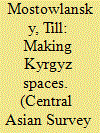

|
|
|
|
|
| Publication |
2012.
|
| Summary/Abstract |
In the past decade local scholars in Murghab, Tajikistan's easternmost district, have published several books in Kyrgyz on the history and culture of the Eastern Pamirs. In their work, the authors address the region's predominantly Kyrgyz population by emphasizing the 'kyrgyzness' of the Eastern Pamirs, which they refer to as Sarykol. The results of these local studies reverberate widely on the ground and have become integrated into everyday interaction. As a consequence, not only the region's history and culture, but also its territory, are perceived through an increasingly ethnicized lens. This paper seeks to explore local history as a way of appropriating space. Following Henri Lefebvre (1974), local history can be defined as an ethno-spatial practice that emphasizes ethnicity. Through an analysis of five works on local history and culture and their embedding in an ethnographic context, this article provides evidence for the significance of local studies in 'kyrgyzizing' space. It also demonstrates, moreover, that international non-governmental organizations, through their funding of such research, are entangled with globalized visions of culture, tradition and ethnicity.
|
|
|
|
|
|
|
|
|
|
|
|
|
|
|
|
| 6 |
ID:
127339


|
|
|
| 7 |
ID:
097894
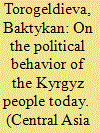

|
|
|
| 8 |
ID:
131608
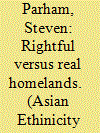

|
|
|
|
|
| Publication |
2014.
|
| Summary/Abstract |
The collapse of the USSR in the early 1990s brought statehood to peoples in the Central Asian borderlands at the interface between the former Soviet Union and the People's Republic of China. In the past two decades, the cautious opening of this once tightly sealed border has led to renewed contact between individuals of the groups sharing the 'Kyrgyz' ethnonym with other individuals from homologous groups who are now citizens of Kyrgyzstan, China (Xinjiang Autonomous Region) and Tajikistan. This article focuses on how Kyrgyz groups beyond the territorial borders of their respective states regard their belonging to a wider Kyrgyz nation. Based on data gathered in anthropological fieldwork, I discuss these groups' respective notions of meken (homeland) and chek-ara (borders) and place such narratives of inclusion and exclusion amongst Kyrgyz groups alongside local rhetoric of ethnic ascription, group affiliation and citizenship, and boundary marking in these borderlands.
|
|
|
|
|
|
|
|
|
|
|
|
|
|
|
|
| 9 |
ID:
090694


|
|
|
|
|
| Publication |
2009.
|
| Summary/Abstract |
What happens if a community is encouraged to imagine itself visually when its political vessel is a modernising nation-state within a multinational communist federation? Cinematic works, in their distillation of time and space, contribute to the kinds of imaginings that sustain nation-states. How this cultural technology reflected and promoted nation-building in the Soviet era is the subject of this article. It explores how the tensions within the diktat 'national in form, socialist in content' played out in practice in the Soviet cultural landscape of 1960s Kyrgyz film, dubbed by Soviet critics as a 'wonder'
|
|
|
|
|
|
|
|
|
|
|
|
|
|
|
|
| 10 |
ID:
126037
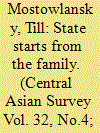

|
|
|
|
|
| Publication |
2013.
|
| Summary/Abstract |
Based on anthropological fieldwork between 2008 and 2011, this article focuses on how people in Tajikistan's eastern Pamirs conceptualize well-being through the establishment of peace and harmony. An exploration of the interactional use of the terms 'peace' and 'harmony' in Kyrgyz and Tajik (tynchtyk, yntymak, tinji, and vahdat) makes manifest that the meanings of these terms are connected to the fields of 'family', 'leadership', and 'state'. Basing their reasoning on the officially promoted analogy between family and state, people in the eastern Pamirs distinguish between social spaces that are related to well-being and those that are not. As a factor of distinction, and crucial to the establishment of peace and harmony, the moral quality of leadership plays an important role. Positive experiences of such leadership as balanced and morally pure are mainly identified and witnessed within families and neighbourhoods and only occasionally in state institutions. This discrepancy raises the question of where to locate boundaries between good and bad, moral and immoral, harmonious and conflictual. Thus, this article contributes not only to the study of local concepts of well-being in Central Asia but also to the study of local concepts of 'ill-being' which challenge them.
|
|
|
|
|
|
|
|
|
|
|
|
|
|
|
|
| 11 |
ID:
129070
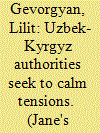

|
|
|
|
|
|
|
|